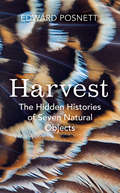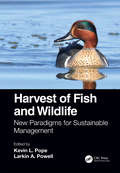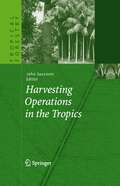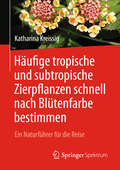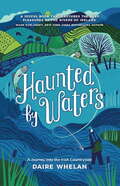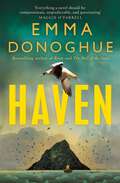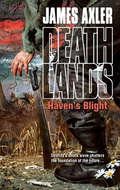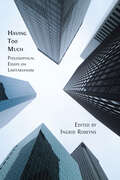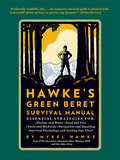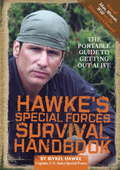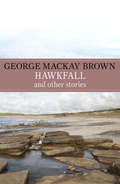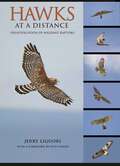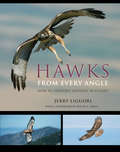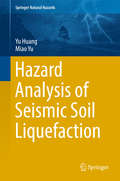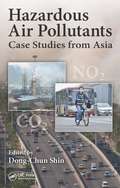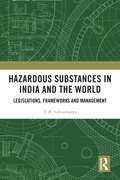- Table View
- List View
Harvest: The Hidden Histories of Seven Natural Objects
by Edward Posnett‘An exceptional first book; Harvest is a subtle, fascinating braiding of travel, cultural and natural history … It is a pleasure and an education to journey with him in these pages’ Robert MacfarlaneIn a centuries-old tradition, farmers in northwestern Iceland scour remote coastal plains for the down of nesting eider ducks.High inside a vast cave in Borneo, men perched atop rickety ladders collect swiftlets’ nests, a delicacy believed to be a cure for almost anything.Eiderdown and edible birds’ nests: both are luxury products, ultimately destined for the super-rich. To the rest of the world these materials are mere commodities but to the harvesters they are all imbued with myth, tradition, folklore and ritual, and form part of a shared identity and history.These objects are two of the seven natural wonders whose stories Harvest tells: eiderdown, vicuña wool, sea silk, vegetable ivory, civet coffee, guano and edible birds’ nests. Harvest follows their journey from the wildest parts of the planet, traversing Iceland, Indonesia, and Peru, to its urban centres, drawing on the voices of the gatherers, shearers and entrepreneurs who harvest, process and trade them.Blending interviews, history and travel writing, Harvest sets these human stories against our changing economic and ecological landscape. What do they tell us about capitalism, global market forces and overharvesting? How does a local micro-economy survive in a hyper-connected world?Harvest makes us see the world with wonder, curiosity and new concern. It is an original and magical new map of our world and its riches.
Harvest of Fish and Wildlife: New Paradigms for Sustainable Management
by Kevin L. PopeHarvest of Fish and Wildlife: New Paradigms for Sustainable Management unites experts in wildlife and fishery sciences for an interdisciplinary overview of harvest management. This book presents unique insights for embracing the complete social-ecological system to ensure a sustainable future. It educates users on evolutionary and population dynamics; social and political influences; hunter and angler behavior; decision processes; impacts of regulations; and stakeholder involvement. Features: Written by twenty-four teams of leading scientists and managers. Promotes transparent justification for fishing and hunting regulations. Provides examples for integrating decision making into management. Emphasizes creativity in management by integrating art and science. This book appeals to population biologists, evolutionary biologists and social scientists. It is a key resource for on-the-ground managers and research scientists developing harvesting applications. As the book’s contributors explain: “Making decisions that are robust to uncertainty…is a paradigm shift with a lot of potential to improve outcomes for fish and wildlife populations.” –Andrew Tyre and Brigitte Tenhumberg “Temporal shifts in system states…must somehow be anticipated and dealt with to derive harvest policies that remain optimal in the long term.” –Michael Conroy “Proactive, effective management of sportspersons…will be essential in the new paradigm of harvest management.” –Matthew Gruntorad and Christopher Chizinski
Harvest of Fish and Wildlife: New Paradigms for Sustainable Management
by Kevin L. Pope Larkin A. PowellHarvest of Fish and Wildlife: New Paradigms for Sustainable Management unites experts in wildlife and fishery sciences for an interdisciplinary overview of harvest management. This book presents unique insights for embracing the complete social-ecological system to ensure a sustainable future. It educates users on evolutionary and population dynamics; social and political influences; hunter and angler behavior; decision processes; impacts of regulations; and stakeholder involvement. Features: Written by twenty-four teams of leading scientists and managers. Promotes transparent justification for fishing and hunting regulations. Provides examples for integrating decision making into management. Emphasizes creativity in management by integrating art and science. This book appeals to population biologists, evolutionary biologists and social scientists. It is a key resource for on-the-ground managers and research scientists developing harvesting applications. As the book’s contributors explain: “Making decisions that are robust to uncertainty…is a paradigm shift with a lot of potential to improve outcomes for fish and wildlife populations.” –Andrew Tyre and Brigitte Tenhumberg “Temporal shifts in system states…must somehow be anticipated and dealt with to derive harvest policies that remain optimal in the long term.” –Michael Conroy “Proactive, effective management of sportspersons…will be essential in the new paradigm of harvest management.” –Matthew Gruntorad and Christopher Chizinski
Harvesting Operations in the Tropics (Tropical Forestry)
by John SessionsThis book brings together information on harvest methods, system productivity, and methods for conducting safe, efficient, and environmentally acceptable operations in tropical forests. It highlights the challenges of harvest operations in the tropics, includes techniques that have been shown to be successful, and discusses newer technologies. Numerical examples are provided to provide clarity for interpreting graphs, procedures, and formulas.
Häufige tropische und subtropische Zierpflanzen schnell nach Blütenfarbe bestimmen: Ein Naturführer für die Reise
by Katharina KreissigDieses Buch ist eine praktische, kompakte Anleitung zur Bestimmung von häufig vorkommenden tropischen und subtropischen Zierpflanzen anhand der Blütenfarbe. Es richtet sich an alle, die sich für Pflanzen interessieren und auf Reisen gern die attraktiven Blütenpflanzen warmer Regionen näher kennenlernen möchten. Sicher hat jeder in einem fremden Land schon einmal eine besonders exotische Blüte bewundert und sich gewünscht zu wissen, um welche Pflanze es sich handelt. Anhand von ansprechenden Fotos und verständlichen Texten liefert dieses Buch einfach und schnell die Antwort. Die Autorin ist eine erfahrene Reiseleiterin und wird unterwegs regelmäßig nach auffälligen Zierpflanzen gefragt. Sie hat die häufig nachgefragten Pflanzen fotografiert und in diesem Naturführer nach Farben gegliedert zusammengestellt. Dieses Buch ist durch seine Bebilderung und einfache Sortierung auch für Einsteiger ohne botanische Vorkenntnisse geeignet.
Haunted by Waters: A Journey into the Irish Countryside
by Daire WhelanAward-winning producer and journalist Daire Whelan had reached the end of another busy week and couldn't shake the feeling that life was passing him by too quickly. Vowing to make a change, he decided to commit to a year of fly fishing and set about planning his route through the wild and rugged landscape of Ireland. Here, in Haunted by Waters: A Journey into the Irish Countryside we travel with Daire throughout a season of fly fishing. But as he searches for a sense of meaning, meeting kindred spirits as he explores the rivers and lakes, Daire finds himself rediscovering the majestic beauty of his native country. From fishing on our most secluded bays and wildest loughs in Connemara and Kerry, to casting a line on the rippling waters of the Suir in Tipperary, catching salmon on the Blackwater in Waterford, and the serenity of the Dodder in Dublin on a workday afternoon, Haunted by Waters is an evocative and stunning love letter to Ireland through a sport rich in tradition and storytelling.
Haven: From the Sunday Times bestselling author of Room
by Emma DonoghueThe hugely anticipated novel from the internationally bestselling author of The Pull of the Stars and Room'Haven is everything a novel should be: compassionate, unpredictable, and questioning. This is Donoghue at her strange, unsettling best.' - Maggie O'Farrell, author of Hamnet'Combines pressure-cooker intensity and radical isolation, to stunning effect.' – Margaret Atwood via TwitterThree men vow to leave the world behind them and start anew . . . In seventh-century Ireland, a scholar and priest called Artt has a dream telling him to leave the sinful world behind. Taking two monks – young Trian and old Cormac – he travels down the river Shannon in search of an isolated spot on which to found a monastery. Drifting out into the Atlantic, the three men find an impossibly steep, bare island inhabited by tens of thousands of birds, and claim it for God. Their extraordinary landing spot is now known as Skellig Michael. But in such a place, far from all other humanity, what will survival mean?Haunting, moving and vividly told, Haven displays Emma Donoghue’s trademark world-building and psychological intensity – but this tale is like nothing she has ever written before . . .
Haven's Blight
by James AxlerThe future rose from the ashes of nuke-scorched America with a vengeance. The unchecked wrath of Deathlands pits Ryan Cawdor and his companions against long odds.
Having The Energy: Having The Energy (Go Green #1)
by Helen Lanz'Go Green: Having the Energy' looks at what energy is, how we use - and waste - it every day, and how this is contributing to global climate change. It explores how we can all reduce our energy use by taking small individual steps that add up to a big saving.Packed with statistics, useful information and handy tips, each title in the tells us what steps we can all take to `go green`.
Having Too Much: (pdf)
by Ingrid RobeynsHaving Too Much is the first academic volume devoted to limitarianism: the idea that the use of economic or ecosystem resources should not exceed certain limits. This concept has deep roots in economic and political thought. One can find similar statements of such limits in thinkers such as Plato, Aquinas, and Spinoza. But Having Too Much is the first time in contemporary political philosophy that limitarianism is explored at length and in detail. Bringing together in one place the best writing from key theorists of limitarianism, this book is an essential contribution to political philosophy in general, and theories of distributive justice in particular. Including some of the key published articles as well as new chapters, Having Too Much is necessary reading for scholars and students of political theory and philosophy, as well as anyone interested in questions of distributive justice.
Hawke's Green Beret Survival Manual: Essential Strategies For: Shelter and Water, Food and Fire, Tools and Medicine, Navigation and Signa
by Mykel HawkeThe perfect home-reference book for both seasoned outdoorsmen and average citizens to learn comprehensive outdoor survival techniques.This practical survival guide from U.S. Special Forces Captain and outdoor survival expert Mykel Hawke includes illustrated instruction on:shelter and waterfood and firetools and medicinenavigation and signalingsurvival psychologyHawke's engaging style and matter-of-fact attitude-not to mention his incredible resume in the survival arena-elevates this book above its competition.
Hawke's Special Forces Survival Handbook: The Portable Guide to Getting Out Alive
by Mykel HawkeU.S. Special Forces Captain and outdoor survival expert Mykel Hawke provides the most practical and accessible survival skills and information necessary to survive in the outdoors.These methods are based on Hawke's 25-year career as a Captain in the U.S. Army, as founder of the survival training company Special Ops Inc, and as a popular survival expert on television-including his Discovery Channel series Man Woman Wild.Geared to the untrained civilian, Hawke's Special Forces Survival Handbook provides illustrated how-to info on shelter, water, fire, food, first aid, tools, navigation, signaling, and survival psychology. Now with a flexibind cover and small format perfect for the glove compartment and backpack, this edition gives readers the tools necessary to survive the worst circumstances and make it out alive.
Hawke's Special Forces Survival Handbook: The Portable Guide to Getting Out Alive
by Mykel HawkeU.S. Special Forces Captain and outdoor survival expert Mykel Hawke provides the most practical and accessible survival skills and information necessary to survive in the outdoors. These methods are based on Hawke's 25-year career as a Captain in the U.S. Army, as founder of the survival training company Special Ops Inc, and as a popular survival expert on television-including his Discovery Channel series Man Woman Wild. Geared to the untrained civilian, Hawke's Special Forces Survival Handbook provides illustrated how-to info on shelter, water, fire, food, first aid, tools, navigation, signaling, and survival psychology. Now with a flexibind cover and small format perfect for the glove compartment and backpack, this edition gives readers the tools necessary to survive the worst circumstances and make it out alive.
Hawkfall
by George Mackay BrownThis collection of sharply-etched fables, dealing with death, legend, love and violence create an Orcadian world that spanning myth and reality - a world set firmly between the sea and the sky - a collection of islands which are life-sustaining and soul refreshing.
Hawks at a Distance: Identification of Migrant Raptors
by Jerry Liguori Pete DunneThe ultimate must-have guide for identifying migrant raptors, Hawks at a Distance is the first volume to focus on distant raptors as they are truly seen in the field. Jerry Liguori, a leading expert on North American raptors, factors in new information and approaches for identifying twenty-nine species of raptor in various lighting situations and settings. The field guide's nineteen full-color portraits, 558 color photos, and 896 black-and-white images portray shapes and plumages for each species from all angles. Useful flight identification criteria are provided and the accompanying text discusses all aspects of in-flight hawk identification, including flight style and behavior. Concentrating on features that are genuinely observable at a distance, this concise and practical field guide is ideal for any aspiring or experienced hawk enthusiast. The first guide to focus on distant raptors as they are viewed in the field New information and approaches for identifying distant raptors Illustrates twenty-nine species in various lighting situations and settings 558 color photos and 896 black-and-white images depicting plumage and shape characteristics All aspects of in-flight hawk identification, including flight style and behavior
Hawks at a Distance: Identification of Migrant Raptors
by Jerry Liguori Pete DunneThe ultimate must-have guide for identifying migrant raptors, Hawks at a Distance is the first volume to focus on distant raptors as they are truly seen in the field. Jerry Liguori, a leading expert on North American raptors, factors in new information and approaches for identifying twenty-nine species of raptor in various lighting situations and settings. The field guide's nineteen full-color portraits, 558 color photos, and 896 black-and-white images portray shapes and plumages for each species from all angles. Useful flight identification criteria are provided and the accompanying text discusses all aspects of in-flight hawk identification, including flight style and behavior. Concentrating on features that are genuinely observable at a distance, this concise and practical field guide is ideal for any aspiring or experienced hawk enthusiast. The first guide to focus on distant raptors as they are viewed in the field New information and approaches for identifying distant raptors Illustrates twenty-nine species in various lighting situations and settings 558 color photos and 896 black-and-white images depicting plumage and shape characteristics All aspects of in-flight hawk identification, including flight style and behavior
Hawks from Every Angle: How to Identify Raptors In Flight
by Jerry Liguori David A. SibleyIdentifying hawks in flight is a tricky business. Across North America, tens of thousands of people gather every spring and fall at more than one thousand known hawk migration sites--from New Jersey's Cape May to California's Golden Gate. Yet, as many discover, a standard field guide, with its emphasis on plumage, is often of little help in identifying those raptors soaring, gliding, or flapping far, far away. Hawks from Every Angle takes hawk identification to new heights. It offers a fresh approach that literally looks at the birds from every angle, compares and contrasts deceptively similar species, and provides the pictures (and words) needed for identification in the field. Jerry Liguori pinpoints innovative, field-tested identification traits for each species from the various angles that they are seen. Featuring 339 striking color photos on 68 color plates and 32 black & white photos, Hawks from Every Angle is unique in presenting a host of meticulously crafted pictures for each of the 19 species it covers in detail--the species most common to migration sites throughout the United States and Canada. All aspects of raptor identification are discussed, including plumage, shape, and flight style traits. For all birders who follow hawk migration and have found themselves wondering if the raptor in the sky matches the one in the guide, Hawks from Every Angle--distilling an expert's years of experience for the first time into a comprehensive array of truly useful photos and other pointers for each species--is quite simply a must. Key Features? The essential new approach to identifying hawks in flight Innovative, accurate, and field-tested identification traits for each species 339 color photos on 68 color plates, 32 black & white photos Compares and contrasts species easily confused with one another, and provides the pictures (and words) needed for identification in the field Covers in detail 19 species common to migration sites throughout the North America Discusses light conditions, how molt can alter the shape of a bird, aberrant plumages, and migration seasons and sites User-friendly format
Hawthorn: The Tree That Has Nourished, Healed, and Inspired Through the Ages
by Bill VaughnOne of humankind’s oldest companions, the hawthorn tree, is bound up in the memories of every recorded age and the plot lines of cultures all across the Northern Hemisphere. Hawthorn examines the little-recognized political, cultural, and natural history of this ancient spiky plant. Used for thousands of years in the impenetrable living fences that defined the landscapes of Europe, the hawthorn eventually helped feed the class antagonism that led to widespread social upheaval. In the American Midwest, hawthorn-inspired hedges on the prairies made nineteenth-century farming economically rewarding for the first time. Later, in Normandy, mazelike hedgerows bristling with these thorns nearly cost the Allies World War II. Bill Vaughn shines light on the full scope of the tree’s influence over human events. He also explores medicinal uses of the hawthorn, the use of its fruit in the world’s first wine, and the symbolic role its spikes and flowers played in pagan beliefs and Christian iconography. As entertaining as it is illuminating, this book is the first full appreciation of the hawthorn’s abundant connections with humanity.
Hazard Analysis of Seismic Soil Liquefaction (Springer Natural Hazards)
by Yu Huang Miao YuThis book presents comprehensive hazard analysis methods for seismic soil liquefaction, providing an update on soil liquefaction by systematically reviewing the phenomenon’s occurrence since the beginning of this century. It also puts forward a range of advanced research methods including in-situ tests, laboratory studies, physical model tests, numerical simulation, and performance-based assessment. Recent seismic liquefaction-related damage to soils and foundations demonstrate the increasing need for the comprehensive hazard analysis of seismic soil liquefaction in order to mitigate this damage and protect human lives. As such the book addresses the comprehensive hazard analysis of seismic soil liquefaction, including factors such as macroscopic characteristics, evaluating the liquefaction potential, dynamic characteristics and deformation processes, providing reliable evaluation results for liquefaction potential and deformation in the context of risk assessment.
Hazardous Air Pollutants: Case Studies from Asia
by Dong-Chun ShinHazardous Air Pollutants: Case Studies from Asia examines the variety of public health problems, such as cardiovascular disease, respiratory disease, increased mortality, and impaired mental health, that are severely affecting multiple Asian countries as a result of exposure to high concentrations of air pollution in the wake of rapid industrializa
Hazardous Substances in India and the World: Legislations, Frameworks and Management
by T. R. SubramanyaThis book examines the nature of hazardous substances and the law governing them, including international conventions, relevant directives and Indian legislation from the pre-independence period to the present. It focuses on legislations passed in the area of hazardous substances, highlighting the background relevant to the continued growth of international environmental law across the globe. It reviews existing strategies available in developing countries and the lack of a systematic approach in administering hazardous substances management programs. The author unfolds the dynamics of hazardous substances, the trade of such substances, transboundary movements and their restrictions through rigorous analyses and evaluation of cases. The book explores the question of liability in hazardous substance litigation, offers an understanding of several judicial decisions in the context, and suggests measures to control and manage the problem of hazardous substances. Authoritative, lucid and comprehensive, this book will be useful to students, researchers and policymakers working on environment, law, international environmental law and development studies, as well as to legal professionals, judicial officers and NGOs.
Hazardous Substances in India and the World: Legislations, Frameworks and Management
by T. R. SubramanyaThis book examines the nature of hazardous substances and the law governing them, including international conventions, relevant directives and Indian legislation from the pre-independence period to the present. It focuses on legislations passed in the area of hazardous substances, highlighting the background relevant to the continued growth of international environmental law across the globe. It reviews existing strategies available in developing countries and the lack of a systematic approach in administering hazardous substances management programs. The author unfolds the dynamics of hazardous substances, the trade of such substances, transboundary movements and their restrictions through rigorous analyses and evaluation of cases. The book explores the question of liability in hazardous substance litigation, offers an understanding of several judicial decisions in the context, and suggests measures to control and manage the problem of hazardous substances. Authoritative, lucid and comprehensive, this book will be useful to students, researchers and policymakers working on environment, law, international environmental law and development studies, as well as to legal professionals, judicial officers and NGOs.
The Haze Problem in Southeast Asia: Palm Oil and Patronage (Routledge Malaysian Studies Series)
by Helena VarkkeyDespite the efforts of Southeast Asian governments and of ASEAN, transboundary haze continues to be a major environmental problem in Southeast Asia. This book demonstrates that the issue is complex, and explains why efforts to solve the problem in purely political terms are ineffective, and likely to continue to be ineffective. The book shows how state-led, state-incentivised agribusiness development lies at the heart of the problem, leading to a large rise in palm oil production, with extensive clearing of forests, leading to deliberate or accidental fires and the resulting haze. Moreover, although the forest clearing is occurring in Indonesia, many of the companies involved are Malaysian and Singaporean; and, further, many of these companies have close relationships with the politicians and officials responsible for addressing the problem and who thereby have a conflict of interest. The author concludes by discussing the huge difficulties involved in overturning this system of 'patronage politics'.
The Haze Problem in Southeast Asia: Palm Oil and Patronage (Routledge Malaysian Studies Series)
by Helena VarkkeyDespite the efforts of Southeast Asian governments and of ASEAN, transboundary haze continues to be a major environmental problem in Southeast Asia. This book demonstrates that the issue is complex, and explains why efforts to solve the problem in purely political terms are ineffective, and likely to continue to be ineffective. The book shows how state-led, state-incentivised agribusiness development lies at the heart of the problem, leading to a large rise in palm oil production, with extensive clearing of forests, leading to deliberate or accidental fires and the resulting haze. Moreover, although the forest clearing is occurring in Indonesia, many of the companies involved are Malaysian and Singaporean; and, further, many of these companies have close relationships with the politicians and officials responsible for addressing the problem and who thereby have a conflict of interest. The author concludes by discussing the huge difficulties involved in overturning this system of 'patronage politics'.
Hazelnut tree (Large Print)
by Rnib BookshareIn this image of a hazelnut tree, the trunk stems from the bottom centre of the page and the leafy branches are just above it. There is a locator dot shown, which will be at the top left of the page when the image is the right way up. There is a picture of a hazelnut leaf in the top left and a picture of a hazelnut in the top right of the page. The leaf stem is to the top right of the leaf itself. The nut is similarly positioned. For scale there is a 'stick man' representing the height of an adult person in the bottom right of the page. This is a small tree sometimes growing to little more than a bush. Its delicious nuts are eaten by people and animals, particularly squirrels. The hazelnut was commonly coppiced (the main trunk cut down a few feet from the ground) which resulted in the growth of long, thin and pliable branches. These were then used for many things from basket making to forming the woven skeleton of wattle and daub walls in mediaeval times. The hazelnut rarely lives longer than 70 years.
